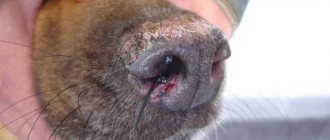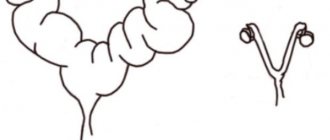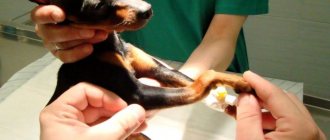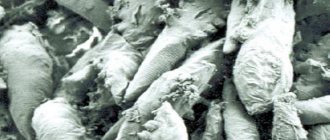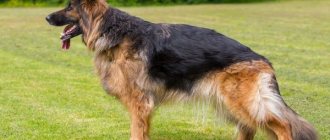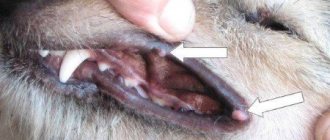Injuries
There are the following types of injuries:
- wounds;
- sprains;
- dislocations.
Wounds
Incised wounds are covered with scab and heal well if the conditionally pathogenic microflora does not penetrate into the joint. The animal needs rest. If the defect is extensive, stitches are applied. Protect the wound from secondary infection. When suppuration develops, antibiotic therapy is used locally, in the form of powders.
Puncture wounds are more difficult to treat. Their consequence is purulent arthritis if the pathogenic microflora enters anaerobic conditions.
Sprains
Distortion (stretching) occurs during sudden jumps, pinching, or being hit by a car. The following symptoms appear the next day:
- lameness;
- soreness;
- the joint is swollen, painful;
- the dog does not lean on its paw, holds it in a half-bent position;
Treatment: a tight bandage is applied and hydrocortisone is injected intramuscularly.
Lameness
Dislocations
The following types of dislocations are distinguished:
- complete, bones completely lose contact;
- subluxation, contact preserved;
- simple, the skin is not damaged;
- open, joint bones exposed;
- congenital, affects mainly puppies;
- familiar.
The pathology is characterized by limited and painful movements. Treatment consists of reduction with local or systemic anesthesia. A bandage is applied that restricts movement for 10–14 days.
What factors can lead to osteomyelitis?
Most often, osteomyelitis is diagnosed in stray dogs. However, the disease can also occur in pets, since its causes are very diverse. Often osteomyelitis occurs against the background of severe systemic bacterial or viral infections that affect the animal’s body and reach the bones.
Causes of osteomyelitis in dogs:
- injuries (bruises, fractures, concussions) . The most common and dangerous of them is a fracture. Due to the fact that the integrity of the skin is compromised, pathogenic bacteria can enter the bone tissue. However, closed fractures also pose a danger. They can cause osteomyelitis, uncomplicated by infection.
- Surgical interventions . We are talking about operations that are performed in the area of the joints or involving them. They often cause bone inflammation, especially in dogs older than 8-9 years.
- Gunshot wounds . For this reason, osteomyelitis is more common in hunting and working dogs. The bullet penetrates the limb, causing not only muscle rupture, but also damage to bone tissue and bone marrow. The result is the development of a severe infectious process.
- Diseases affecting the head area . These include rhinitis, inflammatory diseases of the ears and even diseases of the oral cavity (for example, periodontitis). Without treatment, they can cause osteomyelitis of the jaw.
- Infectious processes in the body . Cellulitis, abscesses and other acute purulent inflammations in dogs require timely and proper treatment. If this is not provided, pathogens will spread throughout the body through the circulatory system, causing osteomyelitis.
Factors that increase the risk of osteomyelitis include vitamin deficiency (often occurs with improper and unbalanced nutrition), frequent hypothermia, autoimmune pathologies, hormonal disorders and exhaustion of the body.
Arthritis
The inflammatory process occurs mainly in old animals. The disease affects massive dogs and spares small dogs. The interosseous joints become painful, and the dog is afraid to move.
The following causes of joint inflammation are identified:
- Functional overload.
- Obesity.
- Genetic predisposition.
The following types of arthritis are distinguished:
- purulent - occurs if the infection gets inside the joint capsule;
- rheumatoid – an autoimmune pathology in which the body perceives its own connective tissue cells as pathogens;
- deforming, is a consequence of constant microtraumas. The bones are deformed, the animal lame;
- dysplasia is a congenital disease of the hip joints. Corrected surgically, the dog is excluded from breeding.
Diagnostics
If the owner suspects that his pet has contracted cancer, then he needs to go to the veterinary clinic. During an in-person examination, the doctor will ask questions about the symptoms your dog is experiencing. The veterinarian will pay attention to the condition of the bone and tissues around it, and then prescribe examinations.
An x-ray must be taken, from which the presence of a tumor can be determined. This method also detects the presence of metastases. A biopsy of fluid from the affected joint may also be ordered. The dog's blood must be taken for analysis. They may also take a biopsy from the central area of the tumor. If the clinic has an MRI machine, it will greatly simplify the diagnosis. With its help, you can see the tumor and sometimes even find metastases.
If a dog exhibits spontaneous fractures, the doctor may suspect osteosarcoma. The disease causes the bones of the affected area to soften. In this case, the fractures will not heal, and the paw must be amputated.
Treatment
The therapeutic strategy is aimed at relieving pain and restoring cartilage tissue. They use medication or surgery, diet, and physical therapy.
Types of joints
Arthrosis
Arthrosis is the result of long-term permanent dystrophic changes in which the interosseous lining is destroyed. The following stages of arthrosis are distinguished:
- Diagnosed only by x-ray.
- The dog often changes its supporting paw. A crunching sound is heard in the joint. Lameness develops, which manifests itself during active movement.
- The joint is deformed. The paw moves to the side, pain is felt.
The disease is incurable. Surgical intervention is indicated for puppies. The animal will feel satisfactory when performing restrictive measures.
Synovitis
Another name is bursitis. Acute synovitis occurs as a result of a bruise. Based on the nature of the exudate, serous or fibrinous inflammation is distinguished. The dog's initial condition is satisfactory. Tumors of a pasty consistency develop over the joint. Local temperatures are rising. When pressed, the dog whines.
Bursitis
With a long course of the disease, the tumor opens, a fistula forms, and purulent inflammation occurs. Treatment of the disease must be entrusted to a specialist, otherwise the dog risks becoming disabled.
Symptoms and diseases of the joints. Causes of occurrence and how to treat them.
One of the main causes of daily suffering for our pets is diseases of the musculoskeletal system. Usually it all starts with a slight lameness, the dog has difficulty getting up, and may whine.
Causes
Problems with the musculoskeletal system can occur at any age. Predisposing factors are:
- Breed predisposition
- Bad heredity
- Musculoskeletal injuries
- Metabolic disease
- Infections
Problems of puppies during the period of active growth
During the period of intensive growth of the puppy, the entire musculoskeletal system - muscles, ligaments, joints, bones - undergoes significant changes. During this period, puppies actively grow and develop, and their skeleton is formed. Most often, it is at this age that defects of the musculoskeletal system appear. Abnormal development is characterized, as a rule, by pathological changes in bone and cartilage tissue.
It is during this period that a very common problem, especially for large breed puppies, is weakness of the ligamentous apparatus. As a rule, the first manifestations are noted after 4 months. The earliest signs may be the so-called “sunken pasterns.” The reasons may be excess weight, poor nutrition, lack of adequate physical activity, slippery flooring, as well as congenital predisposition.
Dysplasia
Young dogs of large breeds often suffer from dysplasia. With this pathology, improper formation of the joint occurs, the head of the joint does not fit tightly to the articular cavity, and during movement it moves relative to it. When moving, the cartilage tissue is erased, flattening and deformation of the joint occurs. As a rule, the hip joints are often affected, less often the elbow joints. With dysplasia, the animal experiences severe pain, which prevents it from leading an active lifestyle.
Discopathy
In chondrodystrophic dog breeds, which include dachshund, basset, bulldog, beagle and some others, there is a risk of intervertebral disc displacement (disc herniation, discopathy), which increases even more after the dog reaches the age of five.
The main function of intervertebral discs is to distribute the load on the spine. With discopathy, degenerative changes in the tissue between the vertebrae occur, the intervertebral disc loses its elasticity, becomes deformed, and shifts, which causes compression of the spinal cord and nerves. As a result, the animal experiences excruciating pain and its motor activity is severely limited.
Arthritis
One of the most common diseases in dogs is arthritis. Arthritis is a collective name for inflammatory diseases. With inflammation, the elasticity of cartilage tissue decreases and the synovial membrane of the articular surfaces is affected. Inflammation occurs, which spreads to surrounding tissues. This causes pain and swelling.
The danger of diseases of the musculoskeletal system is that they are asymptomatic for quite a long time. An attentive attitude towards your four-legged companion will allow you to quickly recognize the problem and begin to treat it as early as possible.
What symptoms should alert the owner?
- Refusal of outdoor games. If activity has decreased and the dog prefers to lie down instead of walking, this is a reason to contact the veterinarian.
- Lameness. Lameness often occurs immediately after sleep and goes away after some time.
- Change in gait. If there are problems with the musculoskeletal system, the firmness of the gait may change, the dog may stagger, and the position of the limbs may change.
- Whining. When moving, unpleasant sensations arise; the dog may whine while walking.
- Unnatural posture. In an effort to get rid of pain, the dog may take unnatural positions.
If you notice any of these symptoms, you should immediately seek qualified help. The veterinarian will conduct a full examination of the animal, take an x-ray and make a diagnosis.
Today, there is a fairly wide range of drugs and methods that allow you to cope with ailments such as arthritis, arthrosis, osteochondropathy, dysplasia, etc. It is now quite possible to help your pet and give him months, or even years, of a happy life. Antibiotics, hormones, and nonsteroidal anti-inflammatory drugs are most often used for treatment. But these drugs have quite a lot of contraindications, as well as unwanted side effects. In contrast to these agents, Chondartron ® has a specific effect on cartilage tissue and tendon-ligamentous apparatus.
Chondartron® reduces inflammation, promotes the production of synovial fluid, which ensures smooth gliding of articular surfaces; accelerates the recovery of the tendon-ligamentous apparatus.
Its use is necessary in all cases where arthritis, arthrosis, bursitis, synovitis are detected, as well as for sprains, tendonitis, and tendovaginitis. The undoubted advantages of the drug are the absence of contraindications and side effects, as well as the ability to reduce the drug load on the body.
General recommendations
In all cases of joint diseases, it is advisable to use nutritional supplements that include glucosamine and chondroitin.
These medications can relieve pain, reduce inflammation and restore cartilage tissue. At the same time, do not forget about reasonable physical activity for the dog. It is unacceptable to let the disease take its course and leave the dog in a calm state. Massage every day and warm your limbs under a lamp.
You should give your dog a massage every day.



